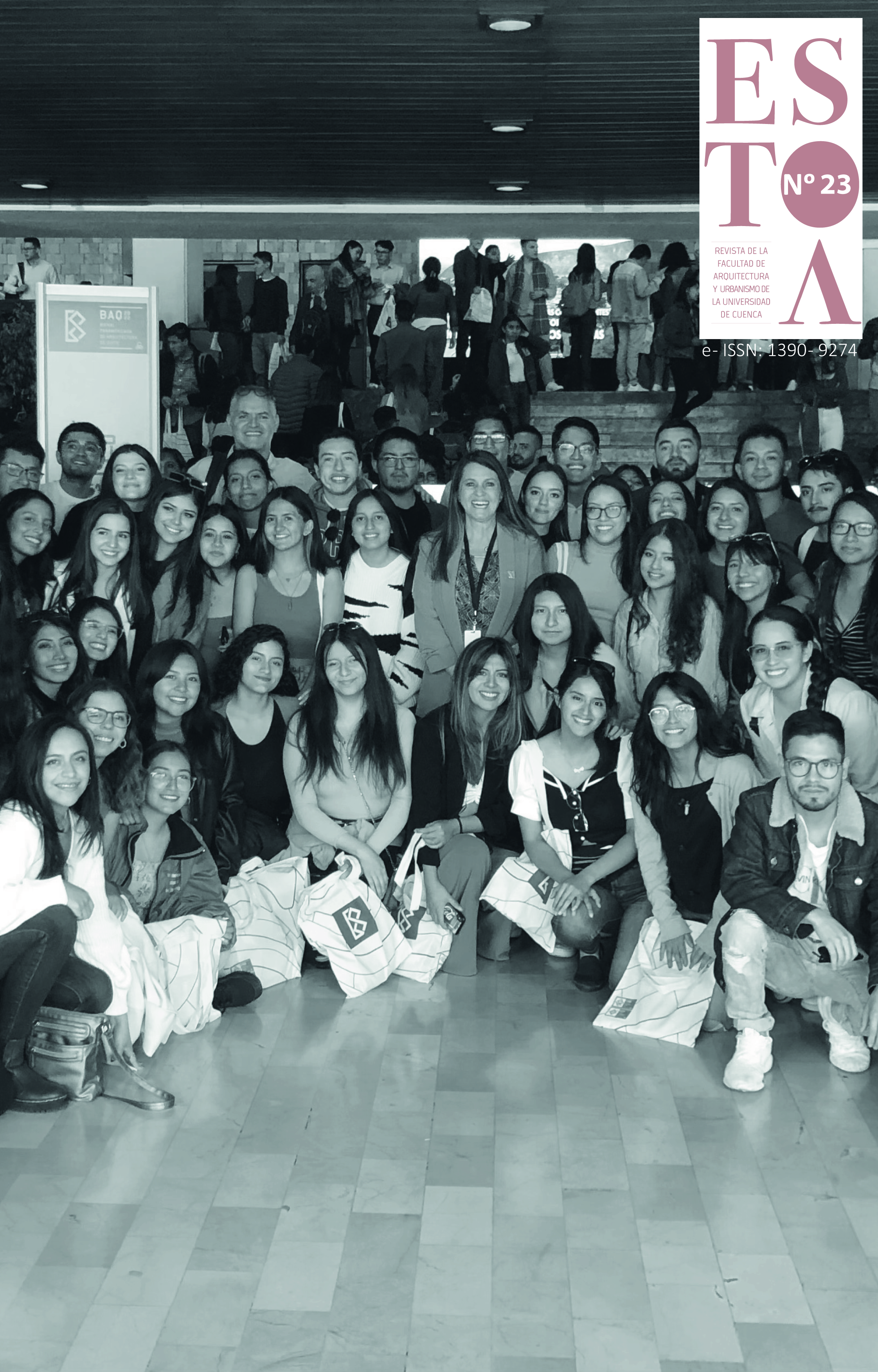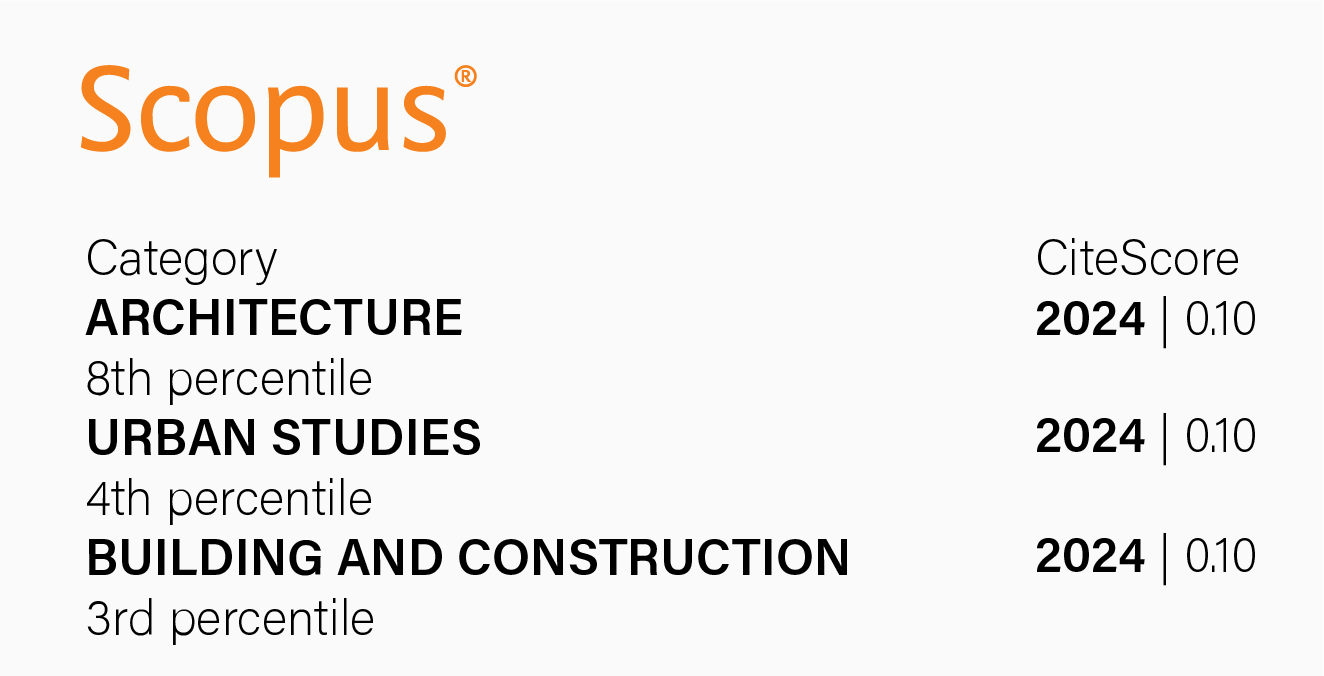Envelope improvements for thermal behavior of rural houses in the Colca Valley, Perú
DOI:
https://doi.org/10.18537/est.v012.n023.a09Keywords:
rural housing, adobe, thermal insulation, weather, self – constructionAbstract
Rural housing in the Andes of Peru is precarious and does not protect communities from the ravages of cold temperatures. This problem has justified the development of projects to improve thermal behavior; however, they have not been developed massively due to their high cost and technical requirement. This article analyzes the thermal behavior of the housing in Colca Valley and offers improvements that can be implemented by the villager. It reviews climatic
conditions, typological and constructive aspects of the dwelling and proposes strategies to improve energy efficiency that are evaluated through a dynamic simulation, and a comparative evaluation of costs. Due to precision limitations
of the software used, it is recommended that the results be complemented with other thermal simulation programs. It is concluded that the roof improvement has a greater impact on the thermal behavior, it decreases energy requirement in 23%; and applying all strategies, does it in 29%. It is recommended to apply
strategies in a progressive way, giving priority to the night-time spaces, to achieve an affordable expense.
Downloads
References
Abanda, H., Tah, J. y Nkeng, G. (2015). 22- Earth-block versus sandcrete-block houses: Embodied energy and CO2 assessment. En F. Pacheco-Torgal, En P.B. Lourenço, J.A. Labrincha, S. Kumar, y P. Chindaprasirt (Eds.),
Eco-Efficient Masonry Bricks and Blocks. Design, Properties and Durability (pp. 481-514). Woodhead Publishing. https://doi.org/10.1016/B978-1-78242-305-8.00022-X
Abanto, G., Karkri, M., Lefebvre, G., Horn, M., Solis, J. y Gómez, M. (2017). Thermal properties of adobe employed in Peruvian rural areas: Experimental results and numerical simulation of a traditional bio-composite material. Case Studies in Construction Materials, 6, 177-191. https://doi.org/10.1016/j.cscm.2017.02.001
Abanto, J. y Montenegro, E. (2016). Los efectos del Proyecto “K’oñichuyawasi Casas Calientes y Limpias” en la salud y calidad de vida de las familias del distrito de Langui en Cusco: Un estudio de caso. [Tesis de maestría, Pontificia Universidad Católica del Perú - PUCP]. https://tesis.pucp.edu.pe/repositorio/handle/20.500.12404/7716
Alzoubi, H. y Malkawi, A. (2019). A Comparative Study for the Traditional and Modern Houses in Terms of Thermal Comfort and Energy Consumption in Umm Qais City, Jordan. Journal of Ecological Engineering, 20(5) 14-22. https://doi.org/10.12911/22998993/105324
Amraoui, K., Sriti, L., Di Turi, S, Ruggiero, F. y Kaihoul, A. (2021). Exploring building’s envelope thermal behavior of the neo-vernacular residential architecture in a hot and dry climate region of Algeria. Building Simulation, 14, 1567–1584. https://doi.org/10.1007/s12273-021-0764-0
Andreoni-Trentacoste, S. y Ganem-Karlen, C. (2021). El rol activo del usuario en la búsqueda de confort térmico de viviendas en clima templado árido. Revista Hábitat Sustentable, 11 (2), 8-21. https://doi.org/10.22320/07190700.2021.11.02.01
Ascanio, J., Terés, J., Muñoz, Y., Lengerke, O. y Del Portillo, L. (2021). Assessing the thermal performance of a conventional architecture in a dry warm climate. Heritage and Sustainable Development, 3, (2), 173-182. https://doi.org/10.37868/hsd.v3i2.66
Banco Central de Reserva del Perú - BCRP. (2016). Informe económico y social de la región Arequipa. Editorial del Banco Central de Reserva del Perú, https://www.bcrp.gob.pe/docs/Proyeccion-Institucional/Encuentros-Regionales/2016/arequipa/ies-arequipa-2016.pdf
Chávez, J., Dulanto, J. y De la Serna, J. (2016). Programa de vivienda rural y desarrollo social en el valle del Colca. Edición: Programa de cooperación hispano peruano.
Código Técnico de la Edificación – CTE. (2010). Catálogo de Elementos Constructivos. Ministerio de Vivienda del Gobierno de España. https://www.codigotecnico.org/pdf/Programas/CEC/CAT-ECv06.3_marzo_10.pdf
Costes, J., Evrard, A., Biot, B., Keutgen, G., Daras, A., Dubois, S., Lebeau, F. y Courard, L. (2017). Thermal conductivity of straw bales: Full size measurements considering the direction of the heat flow. Buildings, 7 (1), 11-25. https://doi.org/10.3390/buildings7010011
Cuitiño, M., Rotondaro, R. y Esteves, A. (2020). Análisis comparativo de aspectos térmicos y resistencias mecánicas de los materiales y los elementos de la construcción con tierra. Revista de Arquitectura, 22 (1), 138-151. http://dx.doi.org/10.14718/RevArq.2020.2348
Espinoza, R., Saavedra, G., Huaylla, F., Gutarra, A., Molina, J., Barrionuevo, R., Y Lau, L. (2009). Evaluación experimental de cambios constructivos para lograr confort térmico en una vivienda altoandina del Perú. Avances en Energías Renovables y Medio Ambiente, 13, 203-210 http://sedici.unlp.edu.ar/bitstream/handle/10915/97335/Documento_completo.pdf-PDFA.pdf?sequence=1&isAllowed=y
Evans, J., De Schiller, S., Garzón, L. (2012). Desempeño térmico de viviendas construidas con quincha. Construcción con Tierra. Publicación periódica de la Facultad de Arquitectura, Diseño y Urbanismo Universidad de Buenos Aires, 5, 93 – 102. https://core.ac.uk/download/pdf/151807279.pdf#page=125
Givoni, B. (1998). Climate Considerations in Building and Urban Design. Van Nostrand Reinhold publishers.
González, Z. (2011). La vivienda andina peruana en el Valle del Colca: Propuesta productiva de sistemas de aprovechamiento de recursos y regulación pasiva a través de la autoconstrucción con materiales locales. El tapial armado mejorado. En Construcción con tierra. Tecnología y arquitectura. Congresos de arquitectura de tierra en Cuenca de Campos 2010/2011 (pp. 367-376). Universidad de Valladolid. http://www5.uva.es/grupotierra/publicaciones/digital/libro2011/2011_9788469481073_p367-376_gonzalez.pdf
Harman, L. (2010). Confort térmico en viviendas altoandinas, un enfoque integral. Care Perú, Balcari editores. https://www.paho.org/cub/dmdocuments/RED%20VIV%20Final%20-%20ManualViviendas%20Altoandinas%20Enf%20Integral.pdf
Heathcote, K. (2011). The thermal performance of earth buildings. Revista Informes de la Construcción, 63(523), 117-126. https://doi.org/10.3989/ic.10.024
Holguino, A., Olivera, L. y Escobar, K. (2018). Confort térmico en una habitación de adobe con sistema de almacenamiento de calor en los andes del Perú. Revista de investigaciones altoandinas. Journal of High Andean Research, 20(3), 289-300. http://dx.doi.org/10.18271/ria.2018.393
Instituto Nacional de Estadística e Informática del Perú – INEI. (2020). Mapa de pobreza monetaria provincial y distrital del Perú, 2018. Editorial INEI. https://www.inei.gob.pe/media/MenuRecursivo/publicaciones_digitales/Est/Lib1718/Libro.pdf
Jiménez, G., Wieser, M. y Biondi, S. (2017). Improving Thermal Performance of Traditional Cabins in the High-Altitude Peruvian Andean Region. En L. Brotas, S. Roaf, F. Nicol. (Eds.), PLEA 2017: 33nd International Conference on Passive and Low Energy Architecture, (pp. 4101 - 4108). Network for Comfort and Energy Use in Buildings. https://plea2017.net/wp-content/themes/plea2017/docs/R_PLEA2017_proceedings_volume_III.pdf
Kajjoba, D., Kasedde, H., Olupot, P.W. y Lwanyaga J.D. (2021). Evaluation of Thermal Comfort and Air Quality of Low-Income Housing in Kampala City, Uganda. Energy and Built Environment, 3(4), 508-524. https://doi.org/10.1016/j.enbenv.2021.05.007
Ministerio de Salud del Perú - MINSA. (2018). Situación epidemiológica de las enfermedades respiratorias agudas (IRAS) en el Perú. Boletín Epidemiológico del Perú, 27 – SE 04, 53 – 68. http://www.dge.gob.pe/portal/docs/vigilancia/boletines/2018/04.pdf
Ministerio de Vivienda, Construcción y Saneamiento del Perú – MVCS. (diciembre del 2019). Programa Nacional de Vivienda Rural, ¿qué hacemos? Gobierno de Perú. https://www.gob.pe/6977-programa-nacional-de-vivienda-rural-que-hacemos
Molina, J. (2016). Evaluación bioclimática de una vivienda rural alto andina de la comunidad de San Francisco de Raymina de Ayacucho. [Tesis de maestría, Universidad Nacional de Ingeniería - UNI]. http://cybertesis.uni.edu.pe/handle/uni/5327
Molina, J., Horn, M., Gómez, M. (2020). Evaluación sistemática del desempeño térmico de un módulo experimental de vivienda altoandina para lograr el confort térmico con energía solar. Tecnia, 3(1), 71-79. https://doi.org/10.21754/tecnia.v30i1.841
Norma Técnica E.080 del Reglamento Nacional de Edificaciones. (2020). Diseño y Construcción con tierra reforzada. Ministerio de Vivienda, Construcción y Saneamiento del Perú - MVCS. https://www.gob.pe/en/institucion/sencico/informes-publicaciones/887225-normas-del-reglamento-nacional-de-edificaciones-rne
Norma Técnica EM.110 del Reglamento Nacional de Edificaciones. (2020). Confort térmico y lumínico con eficiencia energética. Ministerio de Vivienda, Construcción y Saneamiento del Perú - MVCS. https://www.gob.pe/en/institucion/sencico/informes-publicaciones/887225-normas-del-reglamento-nacional-de-edificaciones-rne
Pulgar, J. (2014). Las 8 regiones naturales del Perú. 12va edición. Pontificia Universidad Católica del Perú - PUCP Fondo Editorial.
Reynoso, L., Carrizo, A., Viegas, G., San Juan, G. (2021). Characterization of an alternative thermal insulation material using recycled expanded polystyrene. Construction and Building Materials, 301. https://doi.org/10.1016/j.conbuildmat.2021.124058
Quagliarini, E., Orazio, M y Lenci, S. (2015). 16 - The properties and durability of adobe earth-based masonry blocks. En F. Pacheco-Torgal, En P.B. Lourenço, J.A. Labrincha, S. Kumar, P. Chindaprasirt (Eds.), Eco-Efficient Masonry Bricks and Blocks. Design, Properties and Durability (pp. 361-378). Woodhead Publishing. https://doi.org/10.1016/B978-1-78242-305-8.00016-4
San Juan, G., Viegas, G., Discoli, C., Pérez, F., Lamónica, M., Ruótolo, C., Güimil, A. (2010). Construcción y ensayo de colectores solares calentadores de aire utilizando materiales no habituales. Avances en Energías Renovables y Medio Ambiente (AVERMA), 14, 7-14. http://sedici.unlp.edu.ar/handle/10915/67329
Servicio Nacional de Meteorología e Hidrología del Perú - SENAMHI (2018) Datos hidrometeorológicos a nivel nacional. Perú. Ministerio de Medio Ambiente. https://www.senamhi.gob.pe/?&p=estaciones
Servicio Nacional de Meteorología e Hidrología del Perú - SENAMHI (2020) Mapa Climático del Perú. Perú. Ministerio de Medio Ambiente. https://www.senamhi.gob.pe/?&p=mapa-climatico-del-peru
Sharma, V., Vinayak, H. y Marwaha, B. (2015). Enhancing sustainability of rural adobe houses of hills by addition of vernacular fiber reinforcement. International Journal of Sustainable Built Environment, 4(2), 348-358. https://doi.org/10.1016/j.ijsbe.2015.07.002
Wieser, M., Rodríguez-Larraín, S. y Onnis, S. (2021). Estrategias bioclimáticas para clima frío tropical de altura. Validación de prototipo en Orduña, Puno, Perú. Estoa. Revista de la Facultad de Arquitectura y Urbanismo de la Universidad de Cuenca, 10(19), 9-19. https://doi.org/10.18537/est.v010.n019.a01
Xu, C., Li, S., Zhang, X. y Shao, S. (2018) Thermal comfort and thermal adaptive behaviours in traditional dwellings: A case study in Nanjing, China. Building and Environment, 142, 153-170. https://doi.org/10.1016/j.buildenv.2018.06.006
Zhang, J., Xu, W., Li, A., Zheng, K. y Zhang, J. (2016). Study on improving thermal environment and energy conservation of quadrangle adobe dwelling. Energy and Buildings, 129, 92-101. https://doi.org/10.1016/j.enbuild.2016.07.048
Zúñiga, A. (2012). Historia de la arquitectura en Arequipa, cuatro investigaciones: Transformación de la arquitectura colonial a la republicana; la catedral de Arequipa; el color en la arquitectura de Arequipa; arquitectura vernácula en el valle del Colca. Editorial de la Universidad Católica de Santa María - UCSM.
Published
How to Cite
Issue
Section
License
Copyright (c) 2022 Estoa. Revista de la Facultad de Arquitectura y Urbanismo

This work is licensed under a Creative Commons Attribution-NonCommercial-ShareAlike 4.0 International License.
The Journal declines any responsibility for possible conflicts derived from the authorship of the works that are published in it.
The University of Cuenca in Ecuador conserves the patrimonial rights (copyright) of the published works and will favor the reuse of the same ones, these can be: copy, use, diffuse, transmit and expose publicly.
Unless otherwise indicated, all contents of the electronic edition are distributed under a Creative Commons Attribution-NonCommercial-ShareAlike 4.0 International License.




